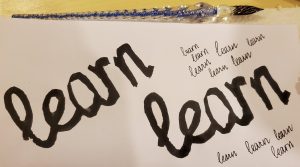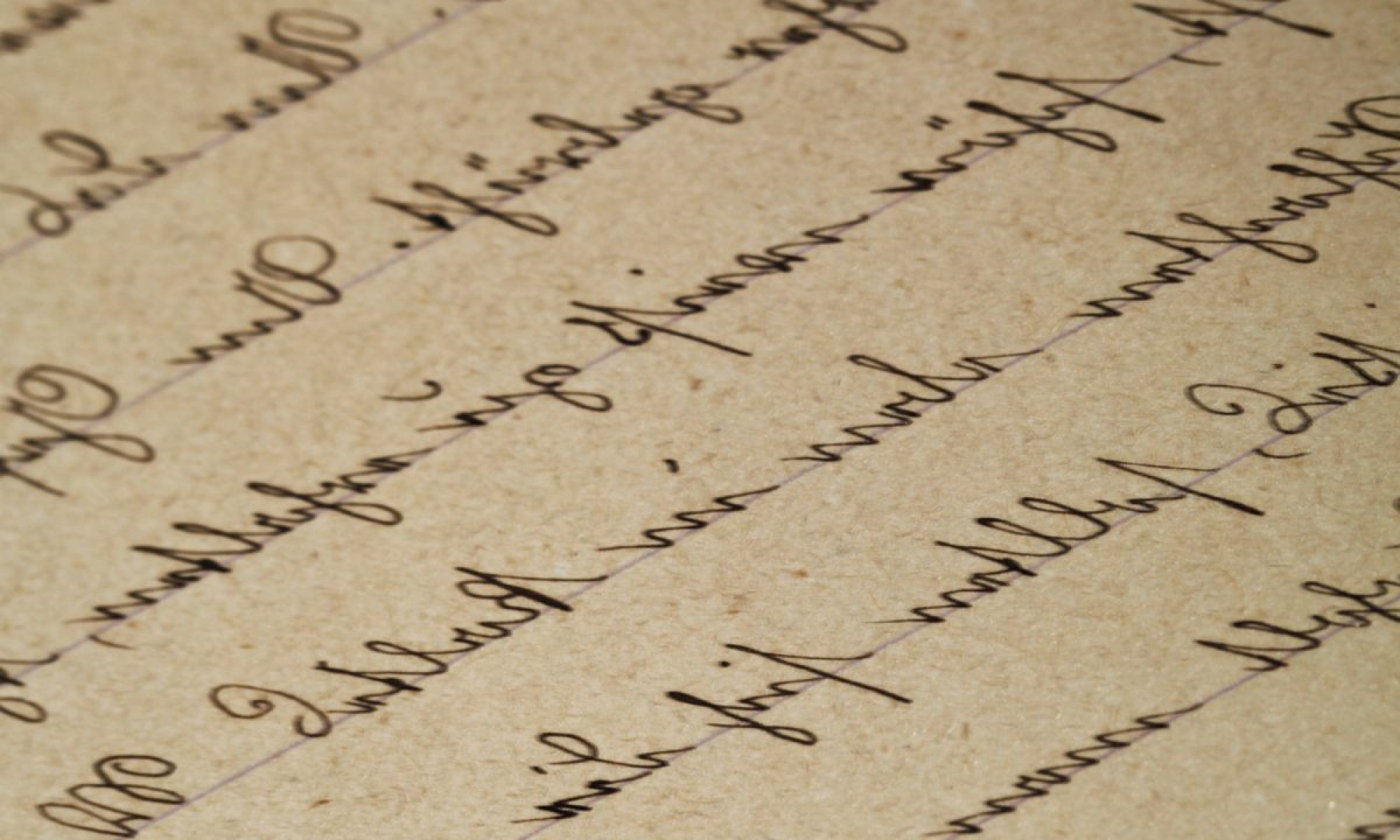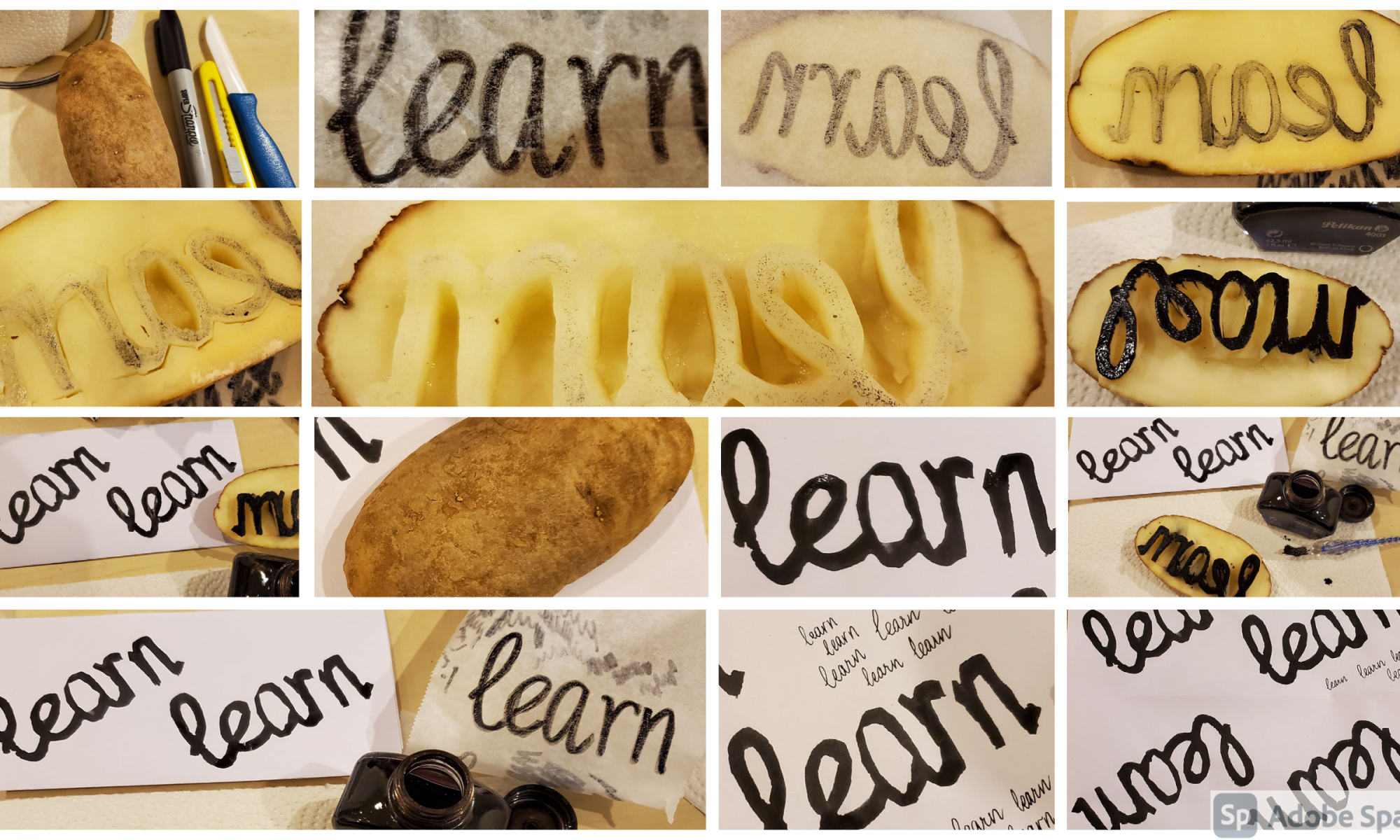I chose to create a potato stamp because I do not remember ever doing this as a child. I enjoy writing and still write whenever I get a chance, but it is less frequent now. My journaling has also decreased in frequency, but I do still make my weekly plans and to-do lists on paper by hand. I thought that the writing task would not be much of a challenge for me, and the potato stamp would be. I am a perfectionist, and I thought that the imperfect lettering carved on the potato would bother me. I cannot just cross out a mistake and re-write it. I cannot use White-Out to hide it. If I mess up, I will have to make a new stamp. Thus, I decided to give it a shot. The word on my potato stamp was initially going to be “hello”, but since it has a repeating letter, I chose “learn”. Before I set out to cut my potato up, I told myself I should learn how to do it correctly, hence, the word choice. The word “learn” is actually perfect word for me; I am always seeking knowledge and not just because I am a teacher. This could be a new recipe, a new skill, or new vocabulary; it could mean “geeking out” on Harry Potter, Star Wars or the Marvel Cinematic Universe; or it could simply mean learning to be a better person.
The Process:
I decided to use lowercase, cursive for my potato stamp because that is how I normally write, and it would pose more of a challenge to try and carve that. I wrote the word “learn” on parchment first because I knew I would have to invert it for the stamp to then print it correctly. As Collier mentions in Cooke’s (2012) video, early printing requires “great consideration; there are no quick highlights and change font”. It requires forethought and planning. I could not just edit the text once it was printed, I would have to start all over again (Cooke, 2012). Rather than imagine a mirror image of the word, I could just flip the parchment paper around and see what the word looks like inverted. I thought of using it as a stencil, but decided to trace the word on the potato just by sight using a Sharpie. However, the Sharpie did not like the wet potato even after I had dried it with a kitchen towel. I kept scribbling on the paper so the ink would continue to flow and was able to make enough of a trace on the potato that I could carve around. This was challenging, as I knew it would be, especially around the curves and inside the letters. I used a sharp ceramic knife and held the blade like a scalpel. Once I was done carving, I knew I did not have any paint, but I do have a lot of ink for my fountain pens. I also do not have a small paintbrush, but I did recently get a glass dip pen, which I thought would be perfect to use for this task. The photo collage above depicts all of the images in order, and here below is a short video of the process as well, and took me between 30 – 45 minutes from start to finish.
The Result:

Once I had the word printed on paper, I saw that it looked more like “leam” rather than “learn”, but printed well, nonetheless. I decided to add a bit of a gap in between the last two letters, and ended up carving out more than I wanted to. It looked like “learn” now, with a noticeable gap between the r and n. The printing is almost identical. The letter “a” is a bit bigger than the “e”, more of its inside got carved out and its top left side is thinner than the rest. The “l” and the “e” look quite nice, and I wish I could fix the “r”. Writing in cursive also made me wonder how the old wooden or metallic stamps printed, and if cursive fonts were possible. I also thought about how official forms and documents ask for names to be “printed” on what is clearly a handwritten document. Is it because of the mechanical stamps that we call it printing when we write in distinct uppercase letters? Overall, I am happier with my potato stamp printing than I thought I would be! The imperfections are a reminder of how far printing has come.
Here below is an image of the word stamped as well as handwritten by the same pen that was used to transfer ink onto the potato:

The Mechanization of Writing:
Although I had fun carving out my five letters and printing them on paper, I would not want to copy an entire book of text, forget illustrations. This task has made me appreciate how the books, pen and paper that we take for granted were at one point luxury items for some. I love “old school” stationery, especially fountain pens, but these have also been modernized. I certainly do not have blood or lead in my inks, or paper that dissolves or rots in my lifetime. The mechanization of writing, or rather, printing, seems inevitable. Its evolution to typing is also inevitable. Personally, there are times when I think writing is quicker and easier, and there are times when I consider typing to be more convenient. As a chemistry teacher, I need to write a lot of chemical reactions and equations. Typing those out and adding symbols, mathematical equations, reaction arrows, etc. although available easily on Word, still feels cumbersome and tedious. Carving that out onto potato stamps is unthinkable and undesirable. Writing out journal entries, or essays, or typing this analysis/reflection, on the other hand, is sometimes more preferable because of the ease of editing. Handwriting, however, seems to have its own charm. I prefer handwritten notes and cards, both as a receiver and sender, because it feels more personal. It has more of an emotional connect and a sense of nostalgia. There are multiple studies that enumerate the benefits of writing to memory retention due to the formation and reinforcement of neural pathways due to reading, contemplating, writing, editing and reading again when one writes. However, in the recent years there are a number of studies that compare the effect of writing vs. typing on memory retention with mixed results. Researchers like Hsiung, Chang, Chen and Sung (2017) and Smoker, Murphy and Rockwell (2009) advocate for pen-and-paper writing for better retention and accuracy, whereas others like Schoen (2012) believe that context matters and typing notes in a lecture context may be more beneficial.
Choosing to write or type based on needs or convenience is a privilege. Not too long ago, this would not have been a choice so easily made, or even possible. Even today, not everybody can choose to type instead of writing. Worse, not everyone has the privilege of learning how to write even. By mechanizing writing and its evolution to the word processors and printers of today, the printed word is ever more accessible in both printed and electronic versions. Even if everyone cannot write, they can have access to texts they can learn to read and then eventually write, hopefully.
Conversely, in the mechanization and ease of access of text, what is somewhat lost is the character and magnitude of how impressive it is to be able to see the printed work come to be. Collier mentions in Cooke’s (2012) video how fascinated his young students are when they see the letters pressed on to the page. The texture, the ink, the machinery, are all remarkable. Printing with the potato stamp, on the one hand, illustrates how easy it is to use any available tool to print with, potato, sponge, wood, etc. On the other hand, it serves to highlight just how much effort and planning is needed to be able to print a whole word, a sentence, a paragraph, a newspaper. Where would we be today without it?
—
References
Cooke, D. (Producer), & Cooke, D. (Director). (2012). Upside down, left to right: A letterpress film. [Video/DVD] UK: Plymouth University. Retrieved from https://youtu.be/n6RqWe1bFpM
Hsiung, H., Chang, Y., Chen, H., & Sung, Y. (2017). Effect of stroke-order learning and handwriting exercises on recognizing and writing chinese characters by chinese as a foreign language learners. Computers in Human Behavior, 74, 303-310. doi:10.1016/j.chb.2017.04.022
Schoen, Ian, “Effects of Method and Context of Note-taking on Memory: Handwriting versus Typing in Lecture and Textbook-Reading Contexts” (2012). Pitzer Senior Theses. 20. https://scholarship.claremont.edu/pitzer_theses/20
Smoker, T. J., Murphy, C. E., & Rockwell, A. K. (2009). Comparing memory for handwriting versus typing. Proceedings of the Human Factors and Ergonomics Society Annual Meeting, 53(22), 1744-1747. doi:10.1177/154193120905302218


Binal! You’re here with me in another class. (I think this might be the 3rd?). Glad to hear it’s your last class, this is only my 4th class – I am going very slowly through this program :/
I added everyone’s feed to my Feedly account (that I only created for this course) and the image of your print stood out. I was not surprised to see it was yours! I’m not exactly sure why, but somehow through my experiences being in your class, I’ve built an idea of your style: precise, well-composed, academic.
For this task I didn’t have any potatoes, and used lino instead (I mean, I majored in printmaking, so I do have printmaking materials lying around!) Still, I used a similar image transferring technique that you attempted and had wondered how the potato-users would fare. I think I too would have just drawn it on by hand as it would be too difficult with the wet surface.
Hi Erin!
Thanks so much for your comment. You’re almost halfway there! And I think in some ways, slow is good – take the time to really process all the information coming at you.
Haha – that is a very accurate perception of me, I must say. Not sure if I should be flattered or worried, lol.. I think I got a little ramble-y towards the end there. I had lots of thoughts on this just running into each other until I just made myself stop.
I am very intrigued and will be going over to your post to see your printing. You are absolutely correct – the wet potato defeated the giant Sharpie! I considered tracing it out with the X-acto knife but thought that might take too long and I would probably cut myself accidentally.